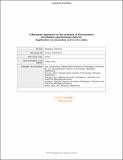Bayesian Approach to the Analysis of Fluorescence Correlation Spectroscopy Data II: Application to Simulated and In Vitro Data
Author(s)
Guo, Syuan-Ming; He, Jun; Monnier, Nilah; Sun, Guangyu; Wohland, Thorsten; Bathe, Mark; ... Show more Show less
DownloadBathe_Bayesian and SI.pdf (4.436Mb)
OPEN_ACCESS_POLICY
Open Access Policy
Creative Commons Attribution-Noncommercial-Share Alike
Terms of use
Metadata
Show full item recordAbstract
Fluorescence correlation spectroscopy (FCS) is a powerful approach to characterizing the binding and transport dynamics of macromolecules. The unbiased interpretation of FCS data relies on the evaluation of multiple competing hypotheses to describe an underlying physical process under study, which is typically unknown a priori. Bayesian inference provides a convenient framework for this evaluation based on the temporal autocorrelation function (TACF), as previously shown theoretically using model TACF curves (He, J., Guo, S., and Bathe, M. Anal. Chem. 2012, 84). Here, we apply this procedure to simulated and experimentally measured photon-count traces analyzed using a multitau correlator, which results in complex noise properties in TACF curves that cannot be modeled easily. As a critical component of our technique, we develop two means of estimating the noise in TACF curves based either on multiple independent TACF curves themselves or a single raw underlying intensity trace, including a general procedure to ensure that independent, uncorrelated samples are used in the latter approach. Using these noise definitions, we demonstrate that the Bayesian approach selects the simplest hypothesis that describes the FCS data based on sampling and signal limitations, naturally avoiding overfitting. Further, we show that model probabilities computed using the Bayesian approach provide a reliability test for the downstream interpretation of model parameter values estimated from FCS data. Our procedure is generally applicable to FCS and image correlation spectroscopy and therefore provides an important advance in the application of these methods to the quantitative biophysical investigation of complex analytical and biological systems.
Date issued
2012-03Department
Massachusetts Institute of Technology. Department of Biological Engineering; Massachusetts Institute of Technology. Department of Chemistry; Massachusetts Institute of Technology. Laboratory for Computational Cell Biology & BiophysicsJournal
Analytical Chemistry
Publisher
American Chemical Society (ACS)
Citation
Guo, Syuan-Ming, Jun He, Nilah Monnier, Guangyu Sun, Thorsten Wohland, and Mark Bathe. “Bayesian Approach to the Analysis of Fluorescence Correlation Spectroscopy Data II: Application to Simulated and In Vitro Data.” Analytical Chemistry 84, no. 9 (May 2012): 3880–3888.
Version: Author's final manuscript
ISSN
0003-2700
1520-6882